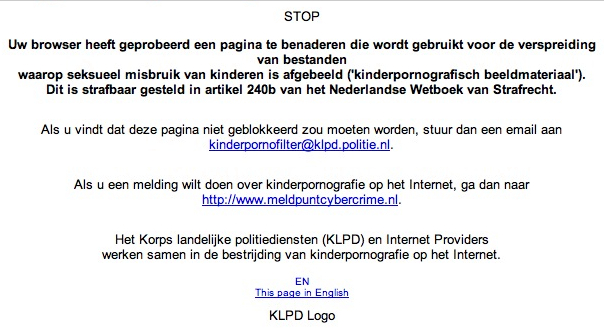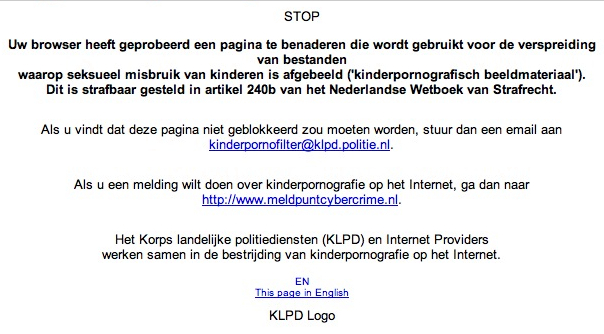 [translation of my column for Het Parool: Kinderporno: niet bestrijden maar verstoppen of February 19, 2008.]
[translation of my column for Het Parool: Kinderporno: niet bestrijden maar verstoppen of February 19, 2008.]
Last year October, Dutch Parliament demanded that the Department of Justice would legally bind ISPs to implement a filter that would block sites containing child pornography. ‘Providers can no longer look the other way; they should be forced to take their social responsibility. It is an outrage that they don’t comply voluntarily,’ member of Parliament Van der Staaij said during the debate. (Webwereld, October 4, 2007).
Most child porn sites, the argument holds, are hosted in countries that fail to take action against child pornography; Eastern Europe and Russia are often cited as the culprits. Thus, the only way for ‘proper’ European countries to get rid of such sites is by filtering them.
In the Netherlands, UPC is the only provider who has implemented a child porn filter. UPC subscribers who try to access a filtered site are presented with an ominous warning on their screen: STOP. Your browser tried to access a page that is being used to distribute files that depict the sexual abuse of children. This is illegal under article 240b of the Dutch Criminal Law.
UPC uses a blacklist that has been compiled by the National Police Forces (KLPD). All other providers have refused, arguing that the list has not been reviewed and that the criteria whereby a site gets blacklisted are unclear and not open to any kind of public scrutiny. There is no method to check whether nasty but legal sites are blacklisted as well, or to check that it is only child porn that is being filtered. Furthermore, filtering doesn’t solve the problem; blacklisting merely hides child porn sites, while the objective should be to shut them down and to arrest the people maintaining them. Only when there is a solid procedure to establish which sites should be blacklisted and there really is no other method of intervention – for instance, when such a site resides outside of Europe and the US – will they consider implementing a child porn filter.
Dutch Parliament called this stance ‘reprehensible’. Child pornography is the ultimate crime; thus, it merits strong measures. The KLPD is just as impatient with the ISPs as Parliament is. As their spokesman Kraszweski stated: ‘The ISPs have the power to do something against child porn sites, but they keep coming up with arguments why they shouldn’t. But we’re taking about child pornography, it’s almost a moral obligation to comply.’ (Webwereld, November 7, 2007).
ISPs in other European countries have implemented a child porn filter too. In Finland, for instance. And in Finland it’s also completely unclear what is being filtered. Matti Nikki tried to find out. He clicked his way through an endless series of sites and was thus able to compile a list of more than one thousand blocked sites, and published it.
His list contains 138 Dutch web sites. Uhm, Dutch sites? But isn’t the Netherlands part of Europe? Can’t – no, shouldn’t – Finland do more than just block them? Why don’t they report these sites to the proper Dutch authorities, so that they can take the appropriate measures, close them down and bring their owners and maintainers to court? Or does Finland perhaps maintain a much stricter definition of what establishes child pornography?
This weekend, I examined the first 40 Dutch sites on the Finnish blacklist. There was a lot of nasty stuff. Sometimes, their legal status was difficult to assess: Dutch law states that it is illegal to distribute pictures of children under eighteen engaged in sexual acts or posing in a sexual way; but age is not always easy to ascertain. However, I encountered numerous pictures of children aged ten or twelve in lurid poses, or fucking or sucking. Obviously child porn, obviously illegal, also under Dutch law. Almost all the sites involved are openly hosted at two Dutch providers, Leaseweb and Webazilla; companies that are easy to find and whom you can serve with a legal notice to shut down a site and to hand over information about the site’s owner.
Then, I checked the same sites via a UPC connection. Part of the sites that Finland labels as child porn sites are accessible via UPC, which means that they are not on the Dutch blacklist. `Evidently, the Fins and the Dutch authorities disagree spectacularly on what qualifies as child pornography, which, in turn, is another reason for ISPs to demand to know on the basis of which criteria the lists are compiled. If specialised police squads can’t figure out which sites should and which sites shouldn’t be blocked, how can a provider make a responsible choice?
Using UPC, I ran into ten blocked sites. One of them did no longer exist, one of them is hosted in the UK, four of them are in the US, and four are hosted in the Netherlands: two at Leaseweb, and two at Webazilla. And again, there was this quaint randomness: I could access plenty of sites that did not differ fundamentally from those that are being blocked. This child porn filter is a weird and unfathomable hodgepodge.
England, the US, and the Netherlands. Again: what was the reason to filter these sites? ‘These sites usually cannot be shut down by the police, because they are often hosted in countries that we have no legal liaisons with.’ (Webwereld, March 23, 2007) Since when are Haarlem and Utrecht located in Russia and out of Dutch jurisdiction?
Critics of child porn filters have said it before: the authorities should not focus on blocking such sites, but on shutting them down. Filtering them away is window dressing, mere show. Blacklisting them does not equal doing something about them, and it sure as hell doesn’t stop the abuse of children. It just prevents us from acknowledging it and from understanding that it is still happening.
The actual reality turns out to be even worse. The Dutch child porn filter contains Dutch child porn sites. To state it bluntly: the Dutch KLPD and the department of Justice are clamouring for a law that will oblige ISPs to make their own insufficiency invisible to the general audience.
According to the KLPD, Leaseweb and Webazilla host child pornography. In that case, they had better do something about it and serve Leaseweb and Webazilla with orders to shut down these sites. Surely, the KLPD and the Department of Justice shouldn’t expect ISPs to do their cleaning for them.

Greets from Finland. Nice, you got real point and here in Finland we are quite (un)happy to see results. Me myself, I say that public knowledge is the way to get rid of CP and it stars here.
CP, an adult plague from which children suffer. Alas it’s one notch more on our belt, the ironclad belt called the pornofication of our society. Yes, I am rather fond of P too; it is in our genes to peek and tom. In my novel “Don’t show, don’t tell” I try to pinpoint where exactly this booming industry drerives from. Nabokov and Darwin, Ruysch and Dawkins, Palahniuk and Blacklegde are ( scientific) authors whom I mention.
But never ever this evidence is to be an alibi for perpetrating these acts of horror. Don’t hide but show: do fight, do tell!
In any case they can not block Usenet and they can not block IRC and they can not block Bit torrent, they can only block port 80!
And then you change your ISP DNS for a free one like OpenDNS and the block on port 80 is gone.
thanks
When the Australian blacklist leaked on Wikileaks, it was visible that pages containing no (child) pornography at all (e.g. a dentist’s page) where on the list, too and that servers hosting sites with child pornography on ’em can be found in Germany, France, Netherlands, … – countries, where it’s already illegal to host this stuff. So why do they want to filter the internet, when they could supress the hosting of those sites directly? And why are they so eager, to hide those blacklists and their criteria from public viewing? Child pronography is ugly, but to me it seems, the actual debate is an excuse to censor the internet.
Here is more about the webazilla child porn hoster, found today – unbelievable:
http://newsonthenet.newsvine.com/_news/2009/07/23/3052971-usnetherlands-child-porn-provider-webazilla-under-attack
Andrew linked:
Wow. Interesting, thanks!